Google Nexus 4 and Nexus 10 Performance Preview
by Anand Lal Shimpi & Brian Klug on November 2, 2012 11:00 AM ESTGPU Performance
This section is particularly exciting because it's our first look at ARM's new Mali-T604 GPU in our standard mobile 3D performance suite. We've already seen the Nexus 4's Adreno 320 in action, but the Nexus 10's behavior here should be interesting to see.
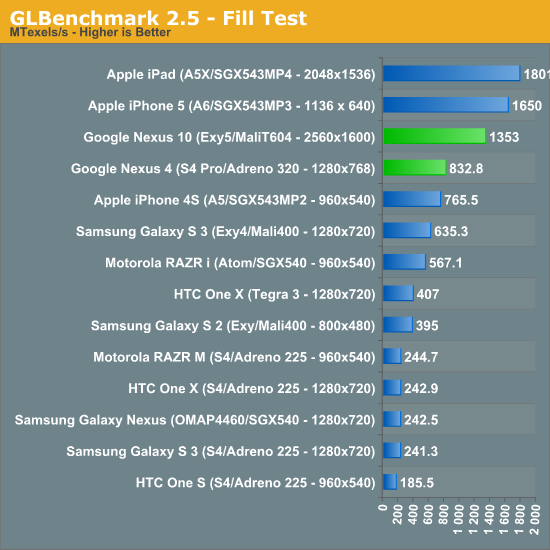
As far as raw fillrates are concerned, both Nexus devices do quite well here at their native resolutions. The iPad and iPhone 5 are both quicker, but we're still good gains over the previous generation of hardware - particularly for the Mali-T604. Compared to the Mali-400MP4 in the Galaxy S 3, we're seeing more than 2x the performance out of ARM's latest GPU.
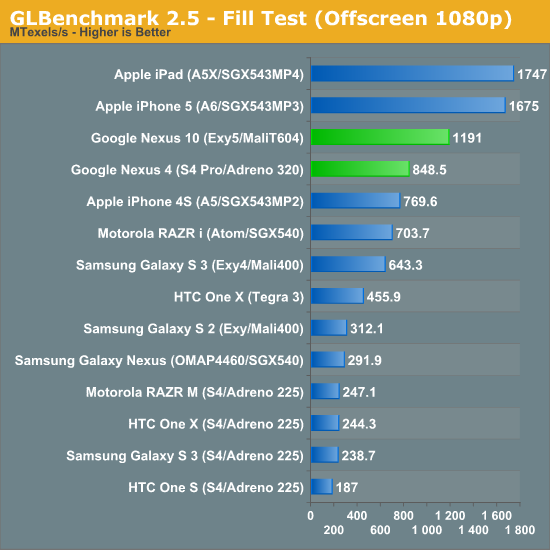
At normalized resolutions the standings don't really change.
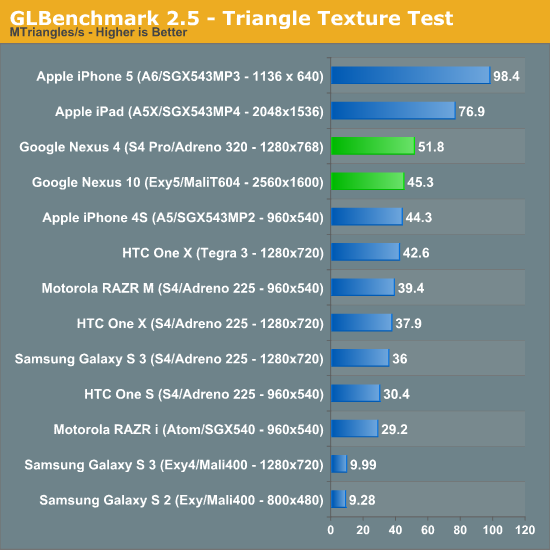
The T604 is ARM's first unified shader architecture, which gives it far more balanced pixel/vertex shader performance. The result is a more than 4x increase in triangle throughput compared to the Mali 400MP4. It's not enough to give the Nexus 10 the edge over the latest Apple devices, but it's a huge improvement over where ARM was in the previous generation. The Adreno 320 continues to be quite strong here as well.
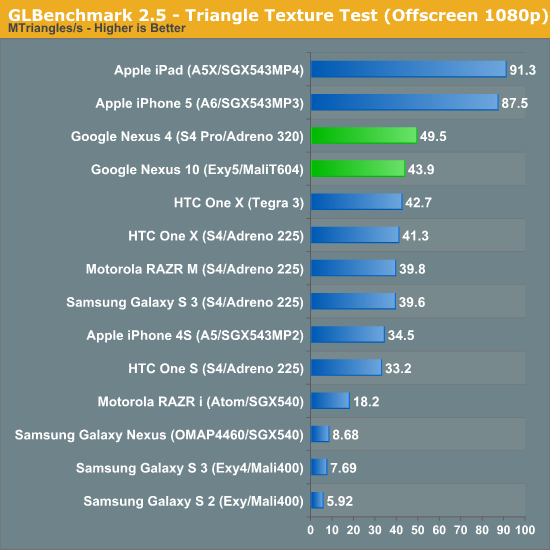
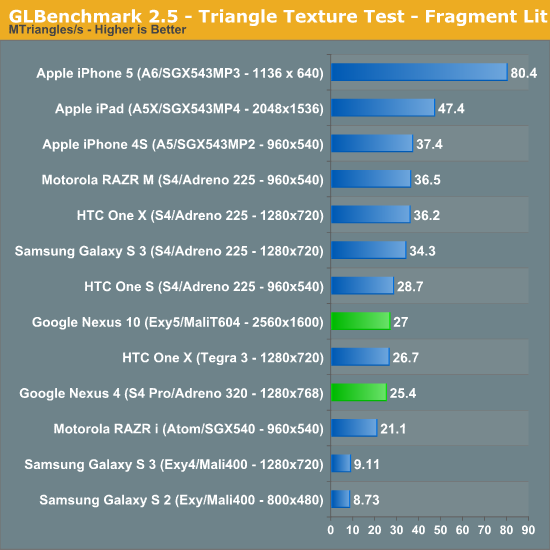
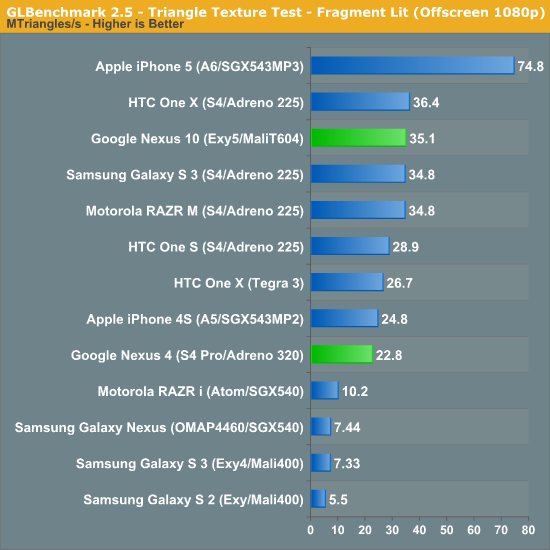
Once again we're seeing huge gains for the Mali-T604 compared to the Mali-400MP4. The Adreno 320 in the Nexus 4 actually performs worse than the Adreno 225 in older devices, possibly due to thermal throttling we saw on the Nexus 4 sample during periods of heavy load.
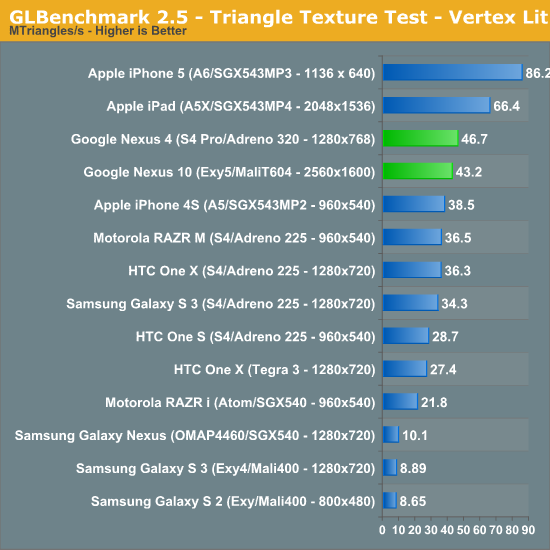
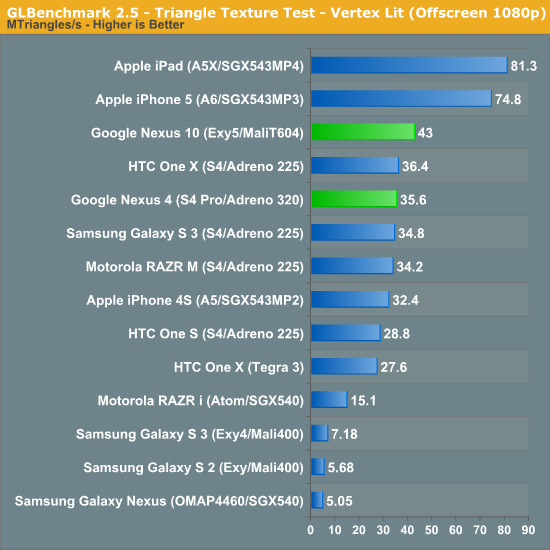
ARM shows the biggest gains here once again thanks to its move to a unified shader architecture. The Adreno 320 does ok here but it's really no better than the 225, I suspect there is some thermal throttling happening on the device.
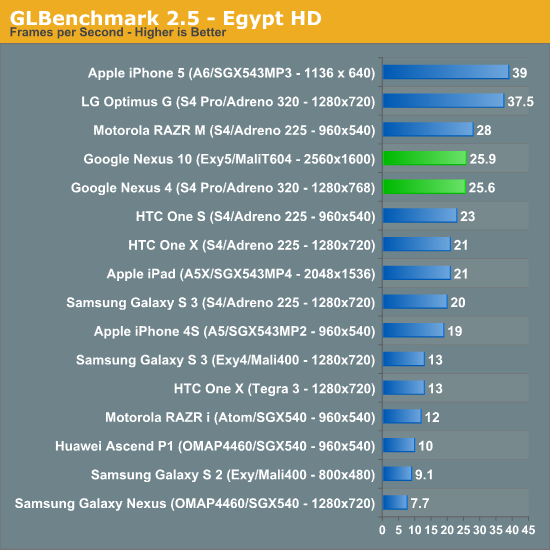
At native resolutions, the Nexus 10 and NExus 4 are both capable of putting out decent frame rates in Egypt HD. What this data tells us is they'll likely be able to run current and even some future titles, at native res, at 30 fps without much of an issue.
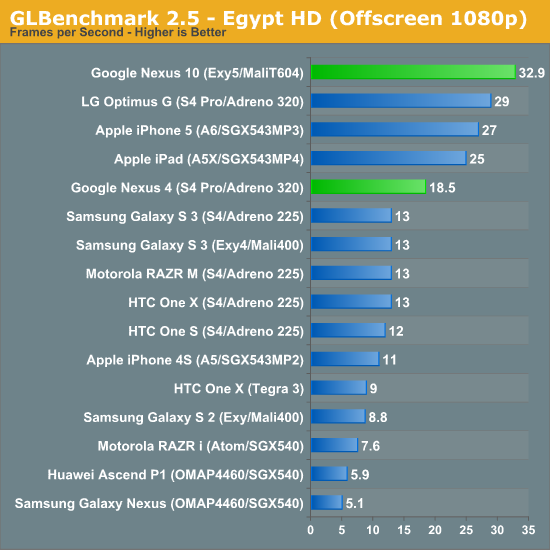
Normalize resolution and the Mali-T604 actually does very well here, setting a new performance record. Despite being based on the same hardware, the Optimus G is able to post a much higher score here than the Nexus 4. The explanation is simple: the Optimus G can't complete a single, continuous run of GLBenchmark 2.5 - the app will run out of texture memory and crash if you try to run through the entire suite in a single setting. The outcome is that the Optimus G avoids some otherwise nasty throttling. The Nexus 4 on the other hand manages to complete everything, but likely quickly throttles its clocks down due to thermal constraints. The Nexus 4 was really hot by the end of our GLBenchmark run, which does point to some thermal throttling going on here. I do wonder if the Snapdragon S4 Pro is a bit too much for a smartphone, and is better suited for a tablet at 28nm.
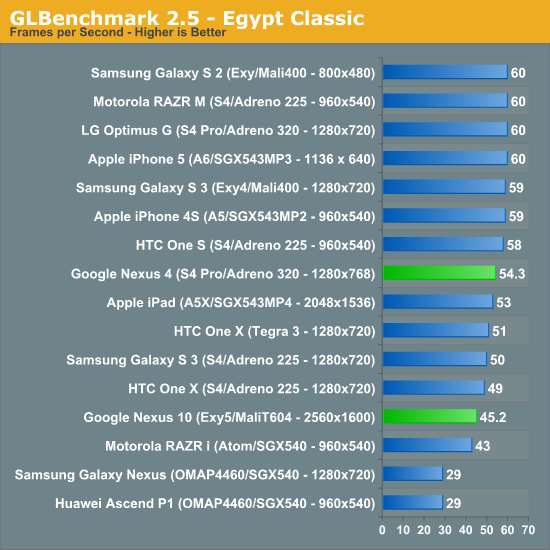
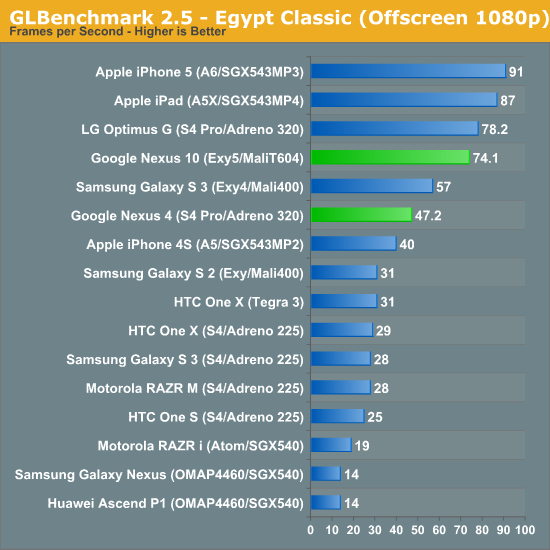
The Egypt Classic numbers are less interesting, but both platforms do well here.
Battery Life
We didn't have time to run through our entire battery life suite, but we do have some relevant results for the two devices. For smartphones, these are our latest web browsing battery life tests:
We regularly load web pages at a fixed interval until the battery dies (all displays are calibrated to 200 nits as always). The differences between this test and our previous one boil down to the amount of network activity and CPU load.
On the network side, we've done a lot more to prevent aggressive browser caching of our web pages. Some caching is important otherwise you end up with a baseband test, but it's clear what we had previously wasn't working. Brian made sure that despite the increased network load, the baseband still had the opportunity to enter its idle state during the course of the benchmark.
We also increased CPU workload along two vectors: we decreased pause time between web page loads and we shifted to full desktop web pages, some of which are very js heavy. The end result is a CPU usage profile that mimics constant, heavy usage beyond just web browsing. Everything you do on your smartphone ends up causing CPU usage peaks - opening applications, navigating around the OS and of course using apps themselves. Our 5th generation web browsing battery life test should map well to more types of smartphone usage, not just idle content consumption of data from web pages.
As always we test across multiple air interfaces (3G, 4G LTE, WiFi), but due to the increased network load we actually find that on a given process technology we see an increase in battery life on faster network connections. The why is quite simple to understand: the faster a page is able to fully render, the quicker all components can drive down to their idle power states.
All Android tests use Chrome and 5GHz WiFi unless otherwise listed.
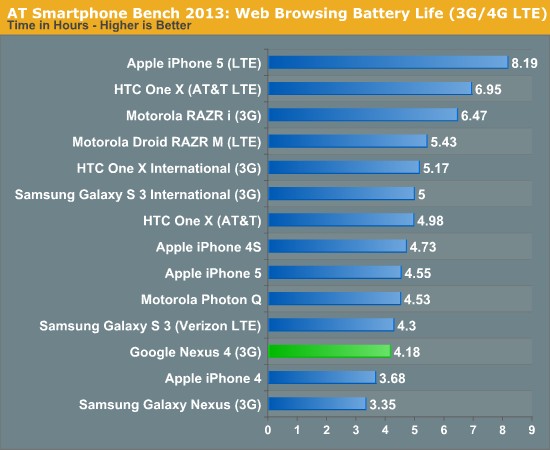
The Nexus 4 doesn't break any records for 3G battery life, it ends up relatively low on our list - even the Galaxy S 3 manages to do better here on 3G.

WiFi battery life is similar to the Galaxy S 3, but again it's not all that impressive compared to some of the other devices in this list.
Our tablet web browsing battery life test isn't directly comparable to the new smartphone tests, so we've got a separate chart for the Nexus 10:
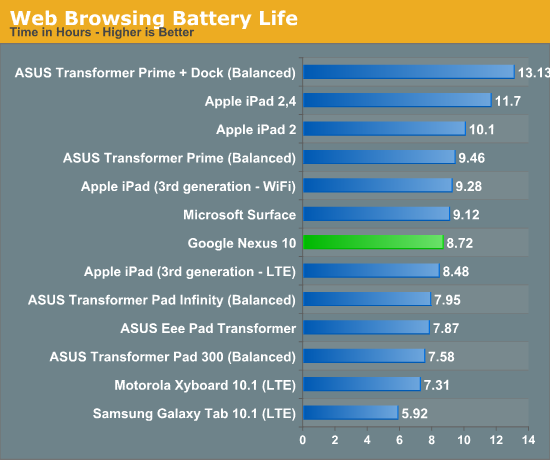
Despite driving a very high res panel, Google is able to deliver relatively competitive battery life with the Nexus 10. Battery capacity is around 80% the size of the 3rd gen iPad and battery life is around 93% of what Apple delivers here. Over 10 hours would be nice to have, but 8 hours of use in this test isn't bad at all. We'll have to do more testing to understand Exynos 5's power behavior a bit better, but so far it doesn't seem that the platform is all that bad from a power consumption standpoint. It remains to be seen how gracefully the Nexus 10 will handle being taxed heavier.
Display
We're still running our big display analysis routines on the new Nexus devices, but the brightness/contrast data below is a little teaser:
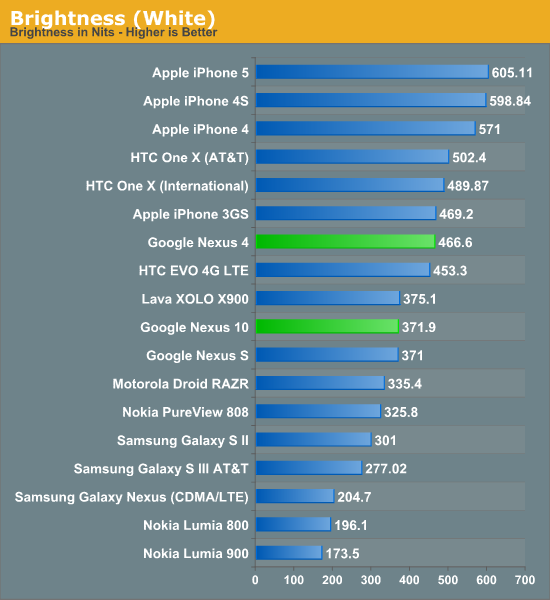
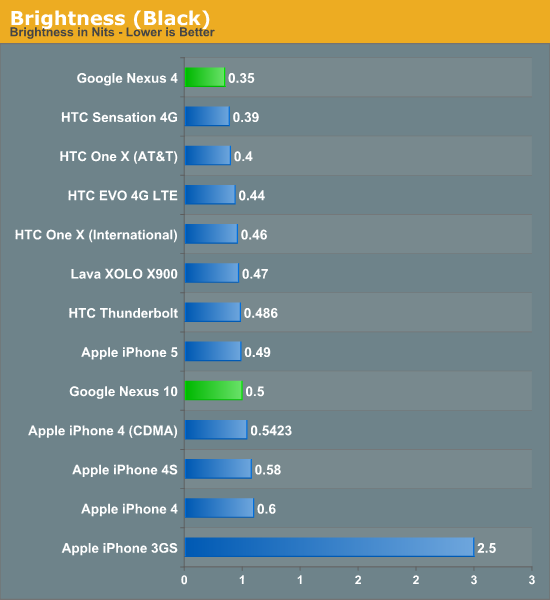
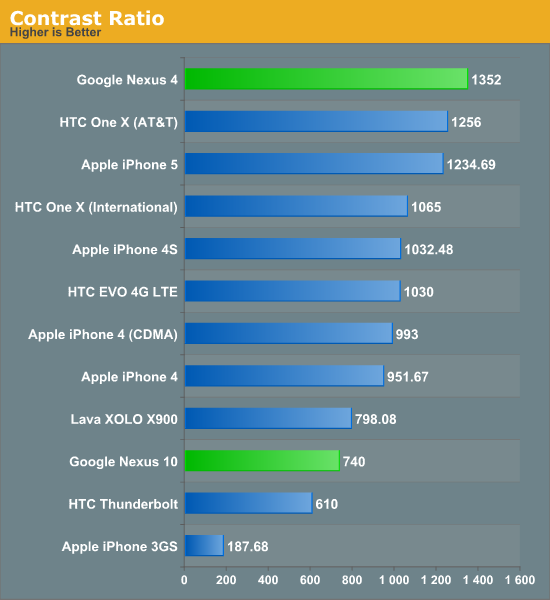
Final Words
We still have a lot of additional writing and testing ahead of us. Stay tuned for our full review of both devices!










244 Comments
View All Comments
KitsuneKnight - Sunday, November 4, 2012 - link
For your second thing, Anand (and the others) have talked about that sort of thing before in their full product reviews (at least in the iPhone 5 one)The benchmark does the same workload across all the phones, and since the 5 has LTE, it'll win due to race-to-sleep, which means (in the benchmark), the 5 is getting to spend much more time idle than the 4. Translate this to real world, and you usually (depending on the user) won't actually see the change going from 3G to LTE, due to the user's workload often changing thanks to the increased speed.
So, at least the idea proposed by them, a lot of people won't see the change in battery life due to their workload becoming much more intense, thanks to the better performance. Can't say if that was the case for you, but it does make sense.
RollingCamel - Sunday, November 4, 2012 - link
Stop teasing us and put the review already! Been checking the website waiting W8, WP8 and 'N4/10 reviews for quite some while. Just publish it!!thesavvymage - Monday, November 5, 2012 - link
Google probably wont allow full reviews until the 13th when the phone is out. They will either post it when the review is ready, or when the NDA expires. Not before either.alkp - Sunday, November 4, 2012 - link
From all the tests above, and only hypothesizing here, we can see what apple has done right, although the qualcomm cpu is great technology and architecture wise, but they did a mistake they seem to always do, the ram is just dual channel 533mhz dd2 9 gb/sec, which is old by today's standard high performance SOCs, apple is using a ddr2 with more than 13 gb/sec , even the 1 year old tegra uses ddr3 (although single channel) I think the cpu and adreno 320 gpu are chocking with low memory rates and not enough data being present for processing, same goes for the exynos why are they using these low clock rams while apple is using quad channel ddr2 to maintain the performance which should be with more than 25 gb/sec speed which is needed for those high res screens and big GPUs, this is a design flow they have better cpu technology but the ram speeds are not on par ..... even if they needed it for power management, apple still does better even in that respect, maybe they turn off channels not being usednoblemo - Monday, November 5, 2012 - link
FLAGGED AS SPAM
Eudoxus - Monday, November 5, 2012 - link
I could use some help interpreting this preview. This really makes it look like Google is releasing a quad-core phone whose performance will be much poorer than that of other dual-core flagship phones, such as the Galaxy S3 and the iPhone 5 (which I assume is dual-core; apologies if I'm wrong). Compared to these other phones, the N4 has web page load times which are twice as long and the rest of the benchmarks are a really mixed bag. The benchmarks from Slashdot show the N4 having about the same 3D scores as my old Nexus S and other phones with supposedly lesser GPUs (see: http://cdn.slashgear.com/wp-content/uploads/2012/1... So what's going on here? Are the benchmarks misleading in some way that is not obvious, or is Google really releasing a quad-core, Adreno 320 flagship phone whose specs manage not to beat much older competitors?I'm really having a hard time deciding what to buy. I don't want to waste my money. These benchmarks tell a pretty grim story about the N4 and make it look like an S3 would be a better choice. If only I wasn't so attached to stock Android...
Thanks for your help in understanding this.
worldbfree4me - Monday, November 5, 2012 - link
So, basically this is AMD vs INTEL! One can spend more and get the Apple or spend less and get the Nexus. I always go with the "Unda Dog" and not to mention the better value, so Google Nexus it is.val580 - Thursday, November 8, 2012 - link
Did you really think you could pay half the price of Samsung and HTC top phones and beat them at benchmarks ?Android experience is said to be the best ever on the N4 so it seems ok ; why excuse it ?
But even Engadget noticed hicups on their devices compared to LG OG.
Personnally I like to see web pages load times comparisons between devices.
I believe Anandtech is intensively testing the device before releasing it's final (always great ) review
Whatever tops out I'm still waiting for LG OG european release
joelol75 - Sunday, November 11, 2012 - link
Quotes from the Apple fanboi that uses House MD as his avatar:"Bit of a non-issue for iOS users since their stock browser consistently dominates......because you didn't want to hear the fact that the already-out iPad will surpass this in performance by a long way...comparing new device vs new device, the Nexus 10 is miles behind the iPad 4..."
1. Would U please shut up! I have an idea. Anatech Stop listing Apple benchmarks in Android reviews so AppFboiz like you stop posting your crAPPaganda. I love the "ummm. I guess Nexus x sucks so I'm getting the Iphone" posts too. Either these fb's have icrap hardware and a Steve Jobs candlelit shrine already or they really are that stupid (in that case they are making the right choice)
NO! Android users don't bail to Apple on a review (maybe decide between other Android devices) so quit posting this crap. I don't post Android propaganda on Apple review sites and personally prefer it if Nokia STOOD BEHIND Maemo instead of flushing their business down the Symbian and Microsoft tubes but anyway the point....
The Nexus . IS new software as well as hardware. Show me a phone with 4.2 on it... and.... the new Iclone is just rehashed same-old, cookie-cutter, designed for obsolescence in no time Apple hardware with an old lock-me-in-Johnny, I-so-stupid so show me how (rather tell me how) to use my device shiny GUI on top of a good (which they didn't write of course but legally stole) FreeBSD OS known as IOS6.
I'm retiring or promoting my Nokia N900 to a carputer project so I can remote start my car by Wifi, SMS, or SSH. It will have a Nexus10 integrated into the dash replacing the Factory radio and will have a Stripped Dell Pentium M laptop with Linux for the backend. All HVAC controls will be touch controlled. Blower motor will be PWM Mosfet. Remote entry will be RFID, NFC (Samsung Tectiles), or SSH. (Solenoid door poppers). Wifi hotspot and GPS, Bluetooth tether and other display duties (FM RDS) will be handled by the N900. Wifi linking and media sync (podcasts auto dl'd) and video capture from the 4 always running cameras as well as OBD2 datalogging (ELM327), voice control and text to speech will be all Linux (ATT Truevoice or Cepstral) Smb and Nfs will be available as the car will always be wifi hs will be handled by a Raspberry Pi and GPIO for all this (no keys! power seat /mirror. memory and other logic will be PicAxe handled. Some voice prompts will be handled with WinBond ISD1000 or so series chips. Radio tuning and rds by si474 ics.
Anyway id rather use my old Nokia N900 than get a ip6. I was deciding btw nexus . and sgs3. Maybe Note 2. Sooo. someone like me would use the iphone as a paperweight. The sheep like 'em I hear...
TekDemon - Tuesday, November 13, 2012 - link
I'm not sure how compelling that ping time is! Surfing the web is often about hitting the server rapidly for little bits of data here and there so that 1.4 second ping time is gonna add quite a bit of time to your loading times. I personally don't care that much about the lack of LTE but that's a crazy high ping time even for HSPA+